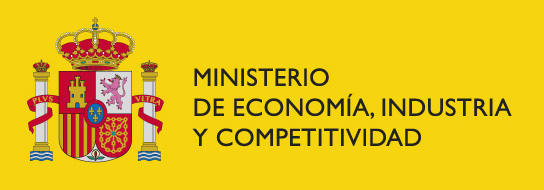Gauge Equations, Geometry and Strings
Concentration Period at ICMAT
Instituto de Ciencias Matemáticas. Madrid, Spain
April 17 - 28, 2017
C/ Nicolás Cabrera, 13-15
Campus Cantoblanco - UAM
28049 Madrid, Spain
www.icmat.es
Telephone: +34 91 2999700
Programme
| April 17 - 21 | Monday | Tuesday | Wednesday | Thursday | Friday |
| 10:30-11:30 | Meetings | Si Li | Si Li | Matt Young | |
| 12:00-13:00 | Vicente Muñoz | Si Li | Aleksander Doan | ||
| 14:30-15:30 | Si Li | ||||
| 16:00-17:00 | Yi Li |
| April 24 - 26 | Monday | Tuesday | Wednesday |
| 10:30-11:30 | Chengjian Yao | ||
| 12:00-13:00 | Conan Leung | Conan Leung | |
| 14:30-15:30 | Oscar Maciá |
All the lectures will take place at the Aula Naranja of the ICMAT.
Programme
• 4 hour Minicourse by:
Si Li (Tsinghua University)
Title: Batalin-Vilkovisky quantization and geometric applications.
Abstract: We discuss the homological method of Batalin-Vilkovisky (BV) quantization in gauge theories. We introduce the basics of infinite dimensional technique of renormalization method, and explain its geometric context in quantum field examples. As applications, we explain its relation with algebraic index theorem in 1d, integrable hierarchies in 2d, and also B-model aspect of mirror symmetry (Kodaira-Spencer gauge theory on Calabi-Yau manifolds).
References:
S. Li, Vertex algebras and quantum master equation, arXiv: 1612.01292[math.QA]
K.Costello and S. Li, Quantum BCOV theory on Calabi-Yau manifolds and the higher genus B-model, arXiv:1201.4501[math.QA]
• Extended lecture (2 hours) by:
Conan Leung (Chinese University of Hong Kong)
Title: SYZ transformation for coisotropic A-branes.
Abstract: I will first describe the Strominger-Yau-Zaslow proposal which gives a geometric explanation of mirror symmetry in terms of Fourier transformation along Lagrangian fibrations. Then I will explain why coisotropic A-branes are needed for symplectic geometry and generalize the SYZ transformation for them using family Nahm transformation. This is mostly a joint work with Kaileung Chan and Yi Zhang and funded by RGC grant of the Hong Kong Government.
• Talks (1 hour) by:
Aleksander Doan (Stony Brook)
Title: Seiberg-Witten multi-monopoles on the product of a circle and a surface.
Abstract: I will discuss a generalization of the Seiberg-Witten equations on 3-manifolds and its relation to higher-dimensional gauge theory. The main new feature is the non-compactness of the moduli space of solutions. I will explain how to tackle this problem and count the solutions with signs when the 3-manifold is the product of a surface and a circle. In this case, the problem of compactness reduces to studying degenerations of solutions to a non-linear scalar PDE resembling the Kazdan-Warner equation.
• Yi Li (University of Luxembourg)
Title: Recent progress on harmonic-Ricci flow.
Abstract: In this talk I will give a recent progress on harmonic-Ricci flow, including existence, convergence, Li-Yau type gradient estimates, Perelmans energy and entropy, heat kernel estimates, etc. In particular, some curvature integral bounds will be discussed on 4D harmonic-Ricci flow. Parts of this work were joint with Dr. Guqiang Wu.
• Oscar Maciá (Universidad de Valencia)
Title: Elementary deformations and the Hyperkaehler/Quaternionic Kaehler correspondence
Abstract: This talk will be an introduction of the twist construction [4] and its application to the description of the c-map [1] between projective special Kaehler, and quaternionic-Kaehler manifolds. Based on joint work [2,3] with Andrew Swann.
[1] S. Cecotti, S. Ferrara, L. Girardello "Geometry of Type II Superstrings and the Moduli of Superconformal Field Theories", Int. J. Mod. Phys. A4 (1989), 2475-2529.
[2] O. Macia, A. F. Swann, Twist geometry of the c-map, Comm. Math. Phys. 336 (2015), 1329–1357.
[3] O. Macia, A. F. Swann, Elementary deformations and the hyperKähler-quaternionic Kähler correspondence, in Real and complex submanifolds, 339–347, Springer Proc. Math. Stat. 106 (2014).
[4] A.F. Swann, "Twisting Hermitian and hypercomplex geometries", Duke Math. J. Volume 155, Number 2 (2010), 403-431.
• Vicente Muñoz (Universidad Complutense de Madrid)
Title: Towards the construction of moduli spaces of Spin(7)-instantons.
Abstract: We review a number of obstacles that one encounters when trying to define well-behaved moduli spaces associated to the Spin(7)-instanton equation on a compact 8-manifold endowed with a (usually non-integrable) Spin(7)-structure. We shall show some advances towards achieving smoothness of the moduli space by perturbing the equations, and some results on orientability of these moduli spaces.
• Chengjian Yao (UL Bruxelles)
Title: Hypersymplectic 4-manifolds, the G_2 Laplacian flow and extension under bounded torsion.
Abstract: Hypersymplectic structure was introduced by Donaldson in his programme of studying the adiabatic limits of G_2 manifolds. It is triple of symplectic forms on a differentiable 4-manifold, spanning maximal positive subspace of \Lambda^2 at each point. HyperKaehler manifolds of dimension 4 gives rich sources of hypersymplectic structures, and were conjectured by Donaldson to be the "only source" in the compact case. We study a geometric flow of such structures, designing to deform a given hypersymplectic structure to a hyperKaehler one in the same cohomology class. We show that the flow does not develop finite time singularity with uniformly bounded torsion. Notice that our flow is a dimensional reduction of the more well-known G_2 Laplacian flow introduced by Hitchin and Bryant to study the existence of metrics with G_2 holonomy. This is a joint work with Joel Fine.
• Matt Young (Chinese University of Hong Kong)
Title: Geometry of tuples in classical Lie algebras via Donaldson-Thomas theory
Abstract: I will describe an explicit method to compute Chow theoretic Betti numbers of moduli spaces of stable tuples in a classical Lie algebra. The method relies on structural results for a class of representations of cohomological Hall algebras, which are of independent interest. These methods apply more generally to identify and compute orientifold Donaldson-Thomas invariants of quivers. Based on joint work with Hans Franzen.
Organizing committee:
(ICMAT)
Mario García-Fernández
(ICMAT)
Oscar García-Prada
(ICMAT)
Tomás Gómez
(ICMAT)
Contact:
mario.garcia@icmat.es


